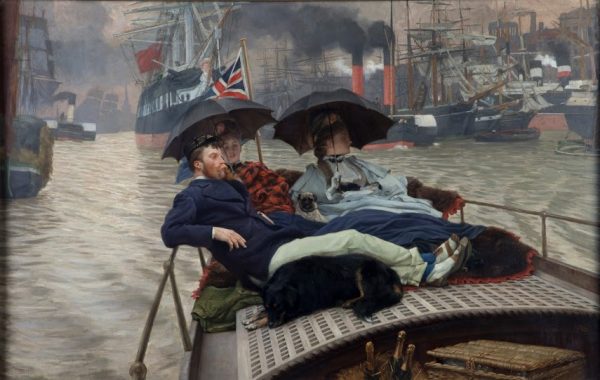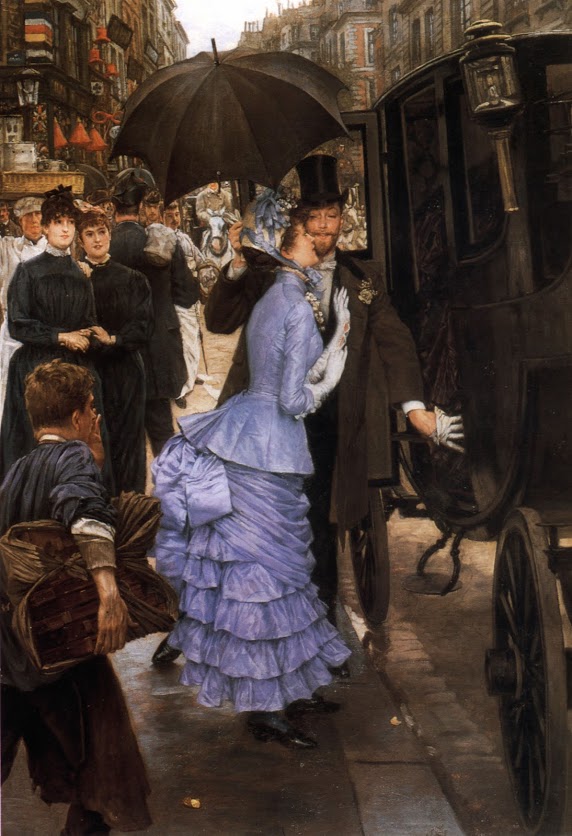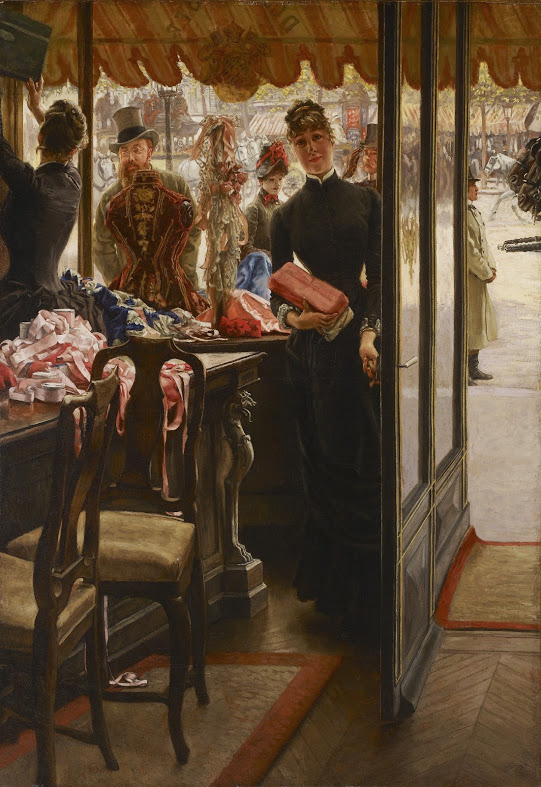James Tissot was one of the most successful French painters of the late 19th century, a contemporary of Manet and Degas, yet most people now have never heard of him.
The Legion of Honor Museum in San Francisco has just opened a major retrospective of Tissot’s work, and it’s an eye-opening show. “Tissot: Fashion & Faith” features about 70 paintings, along with drawings, photographs, and other supporting works. It traces his output from early, sometimes odd, historical scenes, through his sophisticated views of bourgeois life in Paris and London, to his late watercolors of biblical scenes.
Born in Nantes in 1836, Tissot was the son of a wealthy family in the textile business. He studied at the Ecole des Beaux Arts in Paris, where he learned the academic style of the time, and exhibited successfully at the Salon of 1866. He served as a sharpshooter in the Franco-Prussian War of 1870-71. He was a mentor of Degas, socialized with the Impressionists, and was invited to join the first Impressionist exhibition in 1876 but declined to participate.
Tissot also chose not to take up the looser, more experimental approach of the Impressionists, continuing to paint in his smooth and realistic style with its fine sense of color and detail. And why should he change? He was already a success in his 30s, much in demand for his portraits among rich and aristocratic Parisians. He didn’t paint peasants toiling in the fields. He was, in a sense, a pre-Impressionist.
After the war, he visited London and then moved there for a decade. During this period he completed The Ball on Shipboard (top image) in about 1874, a panoramic view of well-dressed travelers on the deck of a large ship decorated with flags and banners overhead. The women — seemingly all of them young and pretty — wear elaborate, colorful, full-skirted dresses. Some sit in chairs, some stroll the deck, some look out to the small boats and hilly landscape in the distance. The men, mostly dressed in dark suits, seem to be much older and often grumpy.
While in London, Tissot fell in love with a beautiful Irish divorcee, Kathleen Newton, who appears in several paintings in the show. Tissot’s work also seems to become more cosmopolitan in this period.

In On the Thames of about 1876, two young women and a red-bearded man recline in the stern of a small boat on the river, accompanied by two dogs, a picnic hamper, and three bottles of Champagne. The women hold umbrellas while they gaze out at the river. In the background is a jumble of large commercial vessels, some belching giant plumes of black smoke. There’s a riot of industrial buildings on the shore. It’s a picture of modernity, a view of the world that goes beyond the salons of the wealthy.
Since Newton and Tissot were both devout Catholics, they were unable to marry, and when she died of tuberculosis in 1882 at the age of 28, Tissot was devastated. He returned to Paris shortly after and continued to work.

In La Femme à Paris: The Bridesmaid of 1883-85, another pretty young woman in a fancy blue dress enters a carriage with the help of a dashing gentleman in a dark suit and top hat. The fashionable couple are the center of attention, yet it’s the crowded urban surroundings that give the picture much of its energy. On the left a pair of servants or shop girls look on in admiration, and in the foreground a street urchin carrying baskets seems to call out to the wealthy couple. In the background is the city itself, teeming with people, horses, tall buildings.

In another painting in Tissot’s great series on the women of Paris, La Femme à Paris: The Shop Girl of 1883–85, he actually focuses on someone who works for a living. Seen from the interior of a tony dress shop, a young woman dressed in black opens the glass door to the sidewalk, as if the viewer were about to leave the shop with the package she holds. To the left is a second shop girl reaching up to retrieve another package and just outside is a bearded gentleman ogling the young woman while other pedestrians stroll by. It’s a terrific document of what the world looked like at the time, including its class differences.
In the last phase of his career, though, Tissot retreated from that world. A few years after Newton’s untimely death, he became increasingly preoccupied with spiritualism and religion, attending seances in hopes of contacting the ghost of his lover.
As an artist he focused on watercolors depicting episodes from the Bible, which were financially successful yet artistically a step backward. To modern eyes, they seem closer to the Victorian penny press than to fine art.
“Tissot: Fashion & Faith,” organized by the Fine Arts Museums of San Francisco and the Musees d’Orsay et de l’Orangerie in Paris, runs through February 9 at the Legion of Honor museum, Lincoln Park, San Francisco. The show will be on view at the Musee d’Orsay from March 23 to July 9, 2020. An extensive catalog is published by Delmonico Books-Prestel.
(Top image: James Tissot, The Ball on Shipboard, about 1874, oil on canvas, collection of Tate Britain. All images are courtesy of the Fine Arts Museums of San Francisco.)
